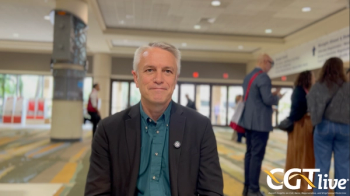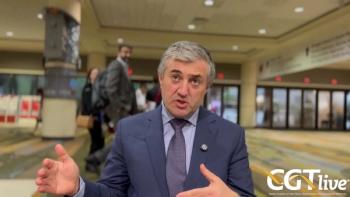
Topotecan Appears Effective for 2nd-Line SCLC Therapy
DUBLIN-Preliminary results suggest that the use of single-agent topotecan (Hycamtin) as second-line therapy for small-cell lung cancer (SCLC) in patients who failed after an initial response to first-line therapy provides efficacy similar to that of the commonly used regimen of cyclophosphamide, doxorubicin (Adriamycin), and vincristine (CAV).
DUBLINPreliminary results suggest that the use of single-agent topotecan (Hycamtin) as second-line therapy for small-cell lung cancer (SCLC) in patients who failed after an initial response to first-line therapy provides efficacy similar to that of the commonly used regimen of cyclophosphamide, doxorubicin (Adriamycin), and vincristine (CAV).
The new data also show a greater symptomatic improvement in patients treated with the topoisomerase I inhibitor, compared with patients assigned to the triple-agent regimen.
The findings are impressive given the lack of effective treatments for SCLC patients who have failed first-line therapy, principal investigator Joan H. Schiller, MD, said at the 8th World Conference on Lung Cancer. Dr. Schiller is associate professor of medicine, University of Wisconsin Cancer Center, Madison.
The results are from an interim analysis of a phase III multicenter trial in which patients with SCLC who had relapsed were randomized to an intravenous infusion of topotecan, 1.5 mg/m2, for five consecutive days every three weeks, or combination therapy with cyclophosphamide, doxorubicin, and vincristine, given IV on day 1 every three weeks.
All patients had achieved a documented partial or complete response to first-line chemotherapy and had sustained a disease recurrence at least 60 days after their last treatment. Median duration of follow-up was 35 weeks for topotecan and 43 weeks for CAV-treated patients.
Study Results
Overall, 20 (21%) of 94 topotecan-treated patients who were evaluable for efficacy when the data were analyzed achieved a partial response vs 13 (14%) of 94 patients treated with the combination regimen. There was one complete response in the triple-agent arm.
The median duration of response was 15 weeks for the topotecan group and 14.6 weeks for the triple-agent group. The median time to response was 6.4 weeks and 5.7 weeks for the two groups. respectively; median time to disease progression was 13.1 weeks and 12.1 weeks, respectively; and median survival, 22.9 weeks and 22.0 weeks, respectively.
On patient questionnaires, 34% of the topotecan cohort cited an improvement in dyspnea, compared with 9% of the combination therapy group. Improvement was defined as a positive change in two consecutive postbaseline assessments separated by a three-week interval.
In addition, 33% of topotecan-treated patients reported an improvement in hoarseness, compared with 12% of the CAV group. An improvement in fatigue was described in 26% and 12% of the two groups, respectively, and an improvement in the ability to carry out daily activities in 31% and 15%, respectively.
The most common side effect was hematologic toxicity, with an 85% incidence of grade 3/4 neutropenia in both arms, Dr. Schiller said. She pointed out, however, that as in prior studies with topotecan, this was predictable, noncu-mulative, and manageable. Nonhemato-logic toxicities were rare in both groups.
Dr. Schiller said that evidence of topotecans efficacy as a single agent was observed in a phase II second-line study of 101 patients from the European Organization for the Research and Treatment of Cancer and in two smaller trials, including a 32-patient second-line study from The M.D. Anderson Cancer Center and a 48-patient first-line study from the Eastern Cooperative Oncology Group.
Commenting on the findings of the present study, Pieter E. Postmus, MD, professor of pulmonology, Free University, Amsterdam, said: That a response rate of nearly 25% was achieved in a multicenter study makes this an important result. The trial was conducted at 44 centers in North America, Europe, and South Africa. Final results are expected later this year.
Newsletter
Stay at the forefront of cutting-edge science with CGT—your direct line to expert insights, breakthrough data, and real-time coverage of the latest advancements in cell and gene therapy.
















































